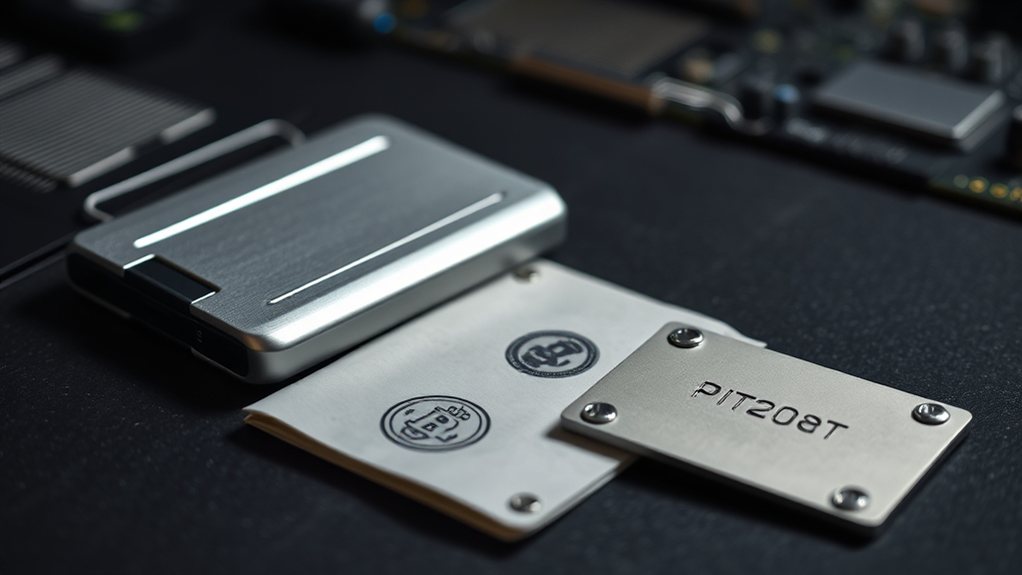A cold wallet is an offline storage device for cryptocurrency that keeps private keys disconnected from the internet. Unlike online "hot wallets," cold wallets provide enhanced security against hackers and malware. They come in various forms including hardware devices (like Ledger or Trezor), paper wallets, and air-gapped computers. While they're less convenient for frequent trading, cold wallets remain the safest option for storing large amounts of digital currency long-term. The following details explore how these secure systems actually work.

Security is the top priority for cryptocurrency owners, and cold wallets provide one of the safest storage solutions available. A cold wallet is an offline cryptocurrency storage device that keeps private keys completely disconnected from the internet. This separation from online networks considerably reduces the risk of hacking, making cold wallets ideal for storing large amounts of digital currency for long periods.
Cold wallets come in several forms. Hardware wallets, like those made by Ledger and Trezor, are small electronic devices specifically designed for secure cryptocurrency storage. Paper wallets are another option, where private keys are printed on physical paper. Some users opt for air-gapped computers, which have never connected to the internet. For durability, steel plates can store engraved keys that resist fire and water damage. Offline software wallets round out the options for those seeking cold storage.
These secure devices incorporate multiple layers of protection. Most hardware wallets encrypt private keys and require PIN codes for access. They typically provide recovery seed phrases—a series of words that can restore access if the device is lost or damaged. Many cold wallets feature tamper-resistant hardware that shows evidence if someone tries to break into the device. Some newer models even offer biometric authentication like fingerprint scanning. Cold wallets fundamentally function by managing the private keys that grant access to digital assets stored on the blockchain.
The operation of cold wallets focuses on keeping private keys isolated. When users need to make a transaction, the wallet generates and signs it offline. The device connects briefly to a computer or smartphone only to broadcast the already-signed transaction to the blockchain network. This process guarantees private keys never touch the internet. Most cold wallets support multiple cryptocurrencies, allowing users to store various digital assets securely in one place. Many cryptocurrency exchanges now employ cold storage methods to protect their users' assets from potential security breaches. Institutions often prefer cold wallets because they prioritize asset protection while minimizing vulnerability to online attacks.
Cold wallets offer considerable advantages over online "hot" wallets. They're immune to remote hacking attempts and safe from malware that might infect computers or phones. Users maintain full control of their private keys rather than trusting a third-party service. This independence makes cold storage particularly valuable for those holding substantial cryptocurrency investments.
Despite these benefits, cold wallets do have some drawbacks. They're less convenient for frequent trading since each transaction requires manual steps. Hardware devices typically cost $50-200, creating an initial expense. There's also the risk of physical loss or damage, which could result in permanent loss of funds without proper backups. Setting up cold wallets requires some technical knowledge, and newer cryptocurrencies might have limited support on older devices.
Cold wallets represent the gold standard in cryptocurrency security, creating an essential barrier between valuable digital assets and potential online threats. While they require more effort to use, this trade-off provides peace of mind for serious cryptocurrency holders concerned about long-term security.
Frequently Asked Questions
How Much Do Cold Wallets Cost?
Cold wallets typically cost between $50 and $250.
Entry-level models are available for $50-$100, while mid-range options run $100-$200. Premium hardware wallets can exceed $200.
Popular brands include the Ledger Nano S Plus ($79), Trezor Model One ($59), and KeepKey ($49).
Higher-priced options like the Ledger Nano X ($149) and Trezor Model T ($219) offer additional features.
Paper wallets are the cheapest option, costing little to nothing.
Can Cold Wallets Be Hacked Remotely?
Cold wallets can't typically be hacked remotely because they're designed to stay offline.
Their physical isolation from the internet creates a protective barrier against online attacks. Hackers can't access private keys stored in these devices through normal network connections.
While no security system is perfect, a properly maintained cold wallet eliminates most remote hacking risks.
Supply chain attacks remain a concern, but they're not technically "remote hacks" after purchase.
What Happens to My Crypto if I Lose My Cold Wallet?
Losing a cold wallet doesn't mean crypto is gone forever. The funds remain on the blockchain, not in the physical device.
Recovery requires the seed phrase created during setup. Without this backup, the crypto becomes inaccessible.
Alternative recovery methods include using private keys or professional recovery services.
That's why experts recommend storing seed phrases securely offline in multiple locations, separate from the wallet itself.
How Often Should I Update My Cold Wallet Software?
Cold wallet software should be updated at least once every six months.
Security experts recommend checking the manufacturer's website monthly for new releases.
Critical security patches require immediate updates.
Users should backup their wallet and recovery phrase before updating.
Firmware should only be downloaded from official sources.
Not updating can expose wallets to security vulnerabilities and potentially lead to loss of funds.
Can I Recover Funds Without My Recovery Phrase?
Recovery without a seed phrase is extremely difficult. Most crypto wallets don't offer a "forgot password" option.
Users have few alternatives:
- Email recovery (some wallets)
- Multi-signature wallet co-signers
- Exchange recovery (if applicable)
- Professional crypto recovery services (expensive)
Success rates remain very low. Blockchain's design intentionally makes unauthorized access nearly impossible.
There's no central authority to help with recovery.










